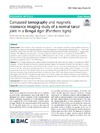Identificador persistente para citar o vincular este elemento:
https://accedacris.ulpgc.es/jspui/handle/10553/69895
| Título: | Computed tomography and magnetic resonance imaging study of a normal tarsal joint in a Bengal tiger (Panthera tigris) | Autores/as: | Arencibia Espinosa, Alberto Matos, Jorge Encinoso, Mario Gil, Francisco Artiles, Alejandro Martínez-Gomariz, Francisco Vázquez Autón, José Maria |
Clasificación UNESCO: | 310907 Patología 3105 Peces y fauna silvestre |
Palabras clave: | Anatomy Computed Tomography Magnetic Resonance Imaging Tarsal Joint Tiger |
Fecha de publicación: | 2019 | Publicación seriada: | Bmc Veterinary Research | Resumen: | In this research, using computed tomography (CT) and magnetic resonance imaging (MRI), we provide a thorough description of the standard appearance of a right tarsal joint in a Bengal tiger (Panthera tigris). CT scans were performed using a bone and soft tissue window setting, and three-dimensional surface reconstructed CT images were obtained. The MRI protocol was based on the use of Spin-echo (SE) T1-weighted and Gradient-echo (GE) STIR T2-weighted pulse sequences. Magnetic resonance (MR) images were taken in the transverse, sagittal and dorsal planes. We also performed anatomical dissections to facilitate the interpretation of the different structures of the tarsus joint and allow comparisons with CT and MRI images. Results: The CT images allowed us to observe differences between the bones and soft tissues of the tarsal joint. When applying the bone window setting, the obtained footage showed the anatomy between the medulla and cortex. Additionally, the trabecular bone was delineated. By contrast, the soft tissue window allowed the main soft tissue structures of the tarsal joint, including ligaments, muscles and tendons, to be differentiated. Footage of the main anatomical structures of the standard tiger tarsus was obtained through MRI. The SE T1-weighted images showed the best evaluation of the cortical, subchondral and trabecular bone of the tibia, fibula, tarsus and metatarsus bones. Nonetheless, the GE STIR T2-weighted images allowed us to better visualize the articular cartilage and synovial fluid. In both MRI pulse sequences, the ligaments and tendons appeared with low signal intensity compared with muscles that were visible with intermediate signal intensity. Conclusions: The results of this CT and MRI study of the Bengal tiger tarsal joint provide some valuable anatomical information and may be useful for diagnosing disorders in this large non-domestic cat. | URI: | https://accedacris.ulpgc.es/handle/10553/69895 | ISSN: | 1746-6148 | DOI: | 10.1186/s12917-019-1865-1 | Fuente: | BMC Veterinary Research [ISSN 1746-6148], v. 15 (1), 126 (2019) |
| Colección: | Artículos |
Citas SCOPUSTM
6
actualizado el 08-jun-2025
Citas de WEB OF SCIENCETM
Citations
5
actualizado el 08-jun-2025
Visitas
183
actualizado el 17-may-2025
Descargas
189
actualizado el 17-may-2025
Google ScholarTM
Verifica
Altmetric
Comparte
Exporta metadatos
Los elementos en ULPGC accedaCRIS están protegidos por derechos de autor con todos los derechos reservados, a menos que se indique lo contrario.
